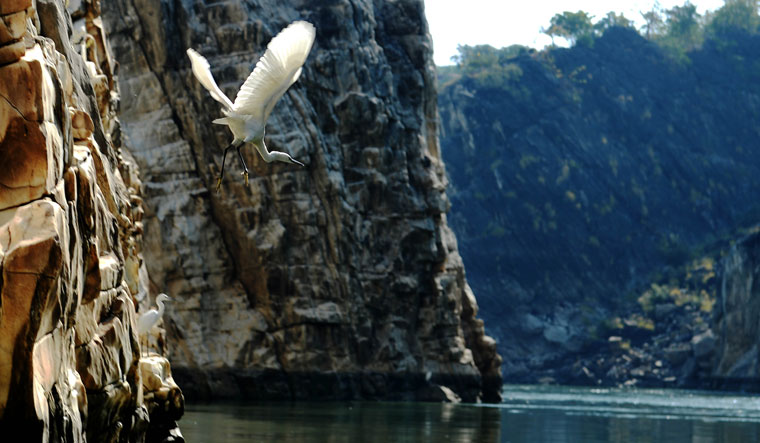In a prestigious moment for Madhya Pradesh, two of its unique natural sites – the Satpura Tiger Reserve in Hoshangabad district and the Bhedaghat-Lamheta Ghat in Narmada valley in Jabalpur district—have made it to the tentative list of UNESCO's world heritages sites.
As many as six sites in the country have made it to the UNESCO tentative list, Union Culture Minister Prahlad Patel announced on Wednesday evening. Madhya Pradesh is the only state from where two sites have been selected. Incidentally, Patel hails from Madhya Pradesh and is an MP from from Damoh in the state.
Madhya Pradesh has three world heritage sites – Khajuraho temple group in Chhatarpur, painted rock shelters of Bhimbetka and Buddhist site of Sanchi, both in Raisen district.
With these two new nominations, Madhya Pradesh now has six nominations on the tentative list, including the iconic monuments of Mandu in Dhar district, the historic ensemble of Orchha in Niwari district, Indore as part of the 'sites of Satyagraha' in India and Chanderi in Ashoknagar as part of the iconic saree weaving clusters of India.
The other nominations from India announced on Wednesday include the Kanchipuram temple group in Tamil Nadu, serial nomination of Maratha Military Architecture (forts) in Maharashtra, Hire Benakal megalithic site in Karnataka and the Ganga ghat (riverfront) in Varanasi, Uttar Pradesh.
Meanwhile, Madhya Pradesh principal secretary of tourism and culture Sheo Shekhar Shukla has expressed happiness over the inclusion of two sites from the state in the UNESCO world heritage tentative list. He said in the next phase, nomination dossiers of these two sites will be submitted to UNESCO as per the process. Only sites of outstanding universal value are included in the tentative lists.
Process for selection of world heritage sites
As per the UNESCO world heritage selection process, after a site is included in the tentative list – which is the first step in the process, an exhaustive nomination file/dossier is to be submitted to the World Heritage Centre (WHC) for review. Once the file is complete, the WHC sends it to appropriate advisory bodies for evaluation.
Since the two sites nominated from Madhya Pradesh are natural sites, the completed files will be sent for independent evaluation to the International Union for Conservation of Nature (IUCN), which will further provide the World Heritage Committee with its evaluation of the nominated sites. The final declaration of World Heritage sites is based on this evaluation.
Shukla said the proposal for nomination of the STR and Bhedaghat-Lametaghat sites was sent to the director general of Archaeological Survey of India (ASI), which is the nodal department for forwarding it to the UNESCO on April 9. He said the MP tourism board, the state forest department, and the Wildlife Institute of India (WII), Dehradun played a major role in completing the nomination process.
About the nominated sites
According to the UNESCO website nomination details, Bhedaghat, often referred to as the Grand Canyon of India, is a town around 25km from Jabalpur, where River Narmada flows through a gorge. Dhuandhar waterfall at Bhedaghat gives the epic view of smoke coming out of the river. River Narmada narrows down on its way through marble rocks and plunges in a waterfall, giving out the appearance of a unique smoke cascade. Several dinosaur fossils have been found in the Narmada Valley, particularly in the Bhedaghat-Lametaghat area of Jabalpur. In 1828, the first Dinosaur fossil (the holotype specimen of the sauropod dinosaur Titanosaurus indicus) was collected from Lameta Bed by British administrator William Sleeman.
The Satpura Tiger Reserve located in the Satpura ranges is one of the major geographical plateaus of India in Hoshangabad district. It is part of the Deccan bio-geographic zone of India. Satpura Tiger Reserve’s environment stands out by its exquisite natural beauty and showcases the importance of tourism of this place. Satpura, meaning 'seven folds', forms a watershed between Narmada and Tapti River and is triangular in shape. It is one of the oldest forest reserves with a well-established tradition of scientific management of forests.
Satpura Tiger Reserve is a prime example of a central Indian highlands ecosystem. It is a unique area of high natural and diverse land resource values. The STR is also one of the globally significant landscapes in terms of tiger conservation. It has the largest tiger-occupied forest, and it also has one of the largest tiger populations.





